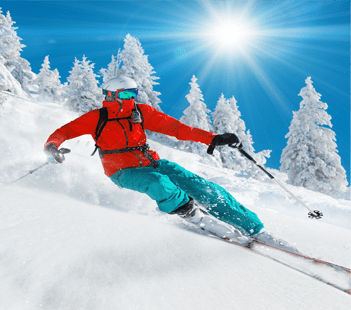Snow Skiing Safety Tips
January 01, 2017
Winter Sports Injury: Snow Skiing
According to the US Consumer Product Safety Commission, there were more than 144,000 snow skiing-related injuries treated in hospitals, doctor's offices, and emergency rooms in 2010. Injuries associated with snowboarding were even greater: 148,000.
Common Ski Injuries:
- Knee injuries are very common, particularly injuries of the anterior cruciate ligament
- Shoulder injuries — such as dislocations and sprains
- Fractures around the shoulder and lower leg
- Head injuries
Snow Skiing Safety Tips:
- Wear the right equipment. Wear several layers of light, loose and water- and wind-resistant clothing for warmth and protection. Layering allows you to accommodate your body's constantly changing temperature. Buy or rent boots and bindings that have been set, adjusted, maintained and tested by a ski shop that follows American Society of Testing and Materials (ASTM) standard job practices.
- Check the binding of each ski before skiing. The bindings must be properly adjusted to your height and weight. Wear appropriate protective gear, including goggles and a helmet. Make sure equipment is clean and there is no dirt or salt between boots, bindings, and binding mechanisms. Proper adjustment of bindings could lessen the likelihood of leg injuries. Test your ability to release bindings muscle power by standing in the skis and twisting and pulling to release the toe and heel pieces.
- Ski with a friend. Skiers should ski with partners and stay within sight of each other. If one partner loses the other, stop and wait. Seek shelter and medical attention immediately if you, or anyone with you, is experiencing hypothermia or frostbite. Make sure everyone is aware of proper procedures for getting help if injuries occur.
- Warm up. Cold muscles are more prone to injury. Warm up with jumping jacks, running or walking in place for 3 to 5 minutes. Take a couple of slow ski runs to complete your warm up.
- Drink plenty of water. Even mild levels of dehydration can affect physical ability and endurance. Drink plenty of water before, during, and after skiing.
- Know the rules. Understand and abide by all rules of the ski resort. Know general safety rules of skiing, such as how to safely stop, merge, and yield to other skiers.
- Take breaks and watch your speed. Many skiing accidents occur when the skier is going too fast, loses control, or hits a mogul. Accidents also occur when skiers are tired.
- Take a lesson. Take lessons from an expert. Studies show that beginners are hurt more frequently. Learn to fall properly.
- Approach lifts with caution. Beware of long scarves that could become entangled in the tow rope.
- Choose trails that match your ability. Avoid trails that are above your skiing abilities.
- Stay on marked trails. Avoid potential avalanche areas such as steep hillsides with little vegetation. Watch for rocks and patches of ice on the ski trails.
- Watch the weather. Pay attention to warnings about upcoming storms and severe drops in temperature. Make adjustments for icy conditions, deep snow powder, and wet snow.
- Wear a helmet. Many fatal ski accidents can be avoided by simply wearing a ski helmet. Helmets are sport-specific. Do not wear a bike helmet on the slopes. Ski helmets should be worn.
Download Snow Skiing Safety Tips PDF
Source: American Academy of Orthopaedic Surgeons ; Consumer Product Safety Commission
© 2012 Denver Health
Manage Your Healthcare From Anywhere, At Any Time
Create a New Account
Existing MyChart Account



